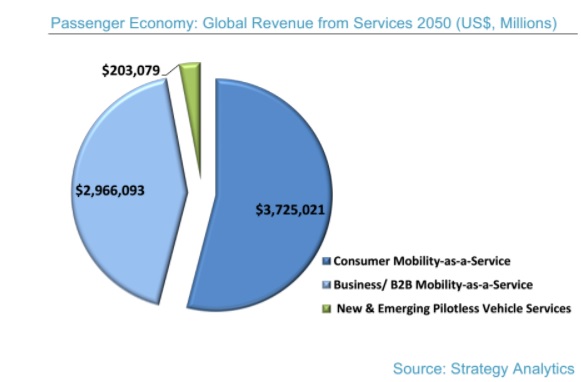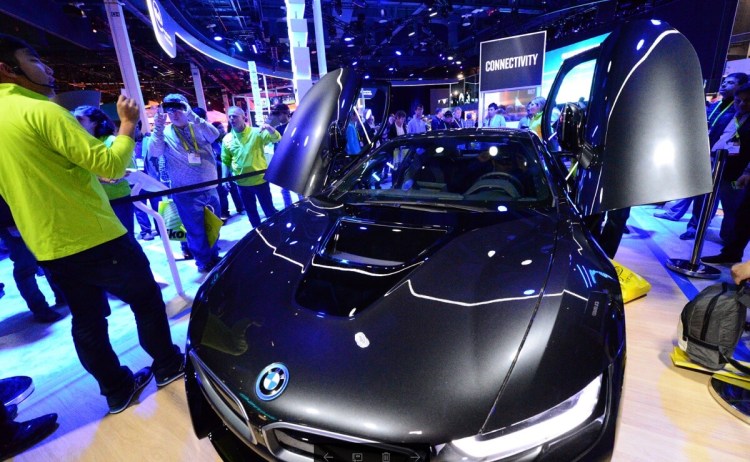Watch all the Transform 2020 sessions on-demand here.
Intel and market researcher Strategy Analytics have applied their collective brainpower to the impact of self-driving cars, and they’re predicting that we’ll see a “Passenger Economy” emerge from all of the services targeted at people while they are no longer driving their cars. By 2050, Intel and Strategy Analytics made the astounding prediction that the passenger economy will have a $7 trillion economic impact.
The companies estimated that the passenger economy (services to fill the idle time while you ride in a car) would be more than twice the size of the sharing economy (based on companies such as Uber or Lyft that share resources across many people) by 2050.
I have to remark how easy it is to ridicule this research. Economists have a hard enough time predicting economic change on a monthly basis. Intel paid Strategy Analytics to look at the economy 33 years from now, and it came up with a figure for the passenger economy being worth $7 trillion in 2050. Despite my light-hearted skepticism, Intel and the researchers are dead serious about the huge impact that self-driving will have.

Above: Intel believes 5G wireless will bring lots of services to cars of the future.
Qualcomm recently looked into the same thing, starting with some very different assumptions. Qualcomm paid for a research paper created by David Teece, professor at the University of California at Berkeley, and market researcher IHS Markit to assess the impact of 5G mobile technology — which Qualcomm is playing a big hand in bringing about — on the economy. That report said 5G would create 22 million jobs and $12.3 trillion in impact on goods and services by 2035.
June 5th: The AI Audit in NYC
Join us next week in NYC to engage with top executive leaders, delving into strategies for auditing AI models to ensure fairness, optimal performance, and ethical compliance across diverse organizations. Secure your attendance for this exclusive invite-only event.
These predictions are surely going to be wildly off the mark, but I won’t be around to check — unless of course there are some real breakthroughs in biotechnology that will keep my brain intact. My prediction is that, thanks to Donald Trump’s withdrawal from the climate change accord, that the headquarters of both Intel and Qualcomm will be underwater by 2050.
That said, I find the discussion that these reports trigger to be very interesting. When I think back to debates about the mobile Internet, I recall a lot of fears that Europe and Japan were going to jump ahead of the U.S. because they set aside the proper amount of bandwidth early for it. And in fact, these fears came to pass. Europe and Asia are far ahead in some respects, with faster wireless broadband and better services on top of those networks. Indeed, maybe companies such as WeChat, Kakao, Supercell, and NCSoft would be based in the U.S. if policy makers had moved faster and planted the seeds for a mobile economy.
Qualcomm’s study found that 91 percent of those surveyed expect 5G to create new products and services that have yet to be invented.
The report assumes that it may take something like a decade for autonomous cars to become mainstream and make a real impact on society. By 2035, the passenger economy will only be about $800 billion. The real growth comes from 2035 to 2050, which is about the same time period when we’ll need to have flying or floating cars because of climate change.

Above: Intel and self-driving cars.
Greg Lindsay, urbanist, mobility futurist, and coauthor of Aerotropolis: The Way We’ll Live Next, said in a press call about the Intel report that the $7 trillion figure might be really conservative because self-driving cars could be the biggest change in transportation since the creation of the “horseless carriage.”
The idea of “mobility as a service” will disrupt long-held patterns of car ownership, maintenance, operations, and usage. Indeed, if I’m not going to drive my car, maybe I don’t need to own it. And if I don’t own it, I won’t take it to Jiffy Lube, and Jiffy Lube will have to serve some giant self-driving car rental agency instead. Mobility as a service is expected to be a $3 trillion industry by 2050, or 43 percent of the total passenger economy.

Above: The breakdown of a $7 trillion passenger economy by 2050.
Consumer use of mobility as a service is expected to be about $3.7 trillion of the passenger economy, or 55 percent of the total. And another $200 billion is expected to come from consumer use of innovative applications and services. From 2035 to 2045, the report estimates 585,000 lives can be saved due to self-driving cars. Collectively, autonomous cars could save us more than 250 million hours of commuting time a year. Reductions in public safety costs could amount to more than $234 billion of the passenger economy from 2035 to 2045. Hmm. Maybe that means there won’t be so many highway patrol jobs?
On the other hand, Lindsay said that if it is no longer such a chore to drive, people might not mind traveling to work over a longer period of time, like maybe two hours, because being a passenger isn’t so taxing as driving. Intel envisions onboard beauty salons, touchscreen tablets for remote collaboration, fast-casual dining, remote vending, mobile health care clinics, and treatment pods. And who needs to use valuable real estate to park cars anymore? In fact, it might make a lot of sense for an apartment landlord to offer an autonomous car service as a part of the rent for an apartment.

Above: An artist’s illustration was part of the “When Cars Can Talk: Readying the Network for 5G and the Autonomous Driving Era” presentation at Intel’s one-day autonomous driving workshop.
Roger Lanctot, director of automotive connected mobility at Strategy Analytics and a coauthor of the report, said that we could actually cram more vehicles onto the road because they will be so good at avoiding collisions. That could help us deal with all of the trucks that Amazon puts on the road because it has wiped out stores. And I’m sure that advertisers will find ways to blast us with location-based advertising.
Kathy Winter, vice president and general manager of Intel’s automated driving solutions division, said in a call that Intel thinks the history of technology is worth remembering here. We’ve seen massive societal transformations as digital business models were ushered in by personal computing, the Internet, ubiquitous connectivity, and smartphones. She believes autonomous driving will do the same. It’s like looking back at the space race and seeing the unpredictable things — like the semiconductor chips that Intel itself makes — that came from it, Lindsay said.
“We started thinking about other evolving economies,” Winter said. “Why do we care about this passenger economy? As more of us understand the future, the more we can plan and adapt. This massive new economy is driving big changes in the way we do things.”
In short, I find it fascinating to think about the changes that will come in society as technology advances. But I still have a hard time thinking about these reports as scientific. By the way, I asked if that $7 trillion estimate had a big margin of error.
“Based on studies looking on similar market sizings like the adoption of 5G, many come out in a similar vicinity,” said Lanctot said. “There is enough to suggest an acceptable margin of error.”


